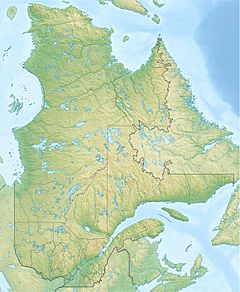Little Watshishou River facts for kids
Quick facts for kids Little Watshishou River |
|
|---|---|
| Native name | Petite rivière Watshishou |
| Country | Canada |
| Province | Quebec |
| Region | Côte-Nord |
| RCM | Minganie |
| Physical characteristics | |
| Main source | Lac Gallienne 50°41′03″N 62°21′42″W / 50.6841667°N 62.3616667°W |
| River mouth | Gulf of Saint Lawrence Baie-Johan-Beetz, Minganie 50°16′19″N 62°37′54″W / 50.2719444°N 62.6316667°W |
| Length | 70 kilometres (43 mi) |
| Basin features | |
| Basin size | 413 square kilometres (159 sq mi) |
The Little Watshishou River (also called Petite rivière Watshishou in French) is a cool river in the eastern part of Quebec, Canada. It's known for its salmon and beautiful nature. This river is a special place for fishing and enjoying the outdoors.
Contents
Where is the Little Watshishou River?
The Little Watshishou River begins its journey in a place called Lake Gallienne. It then flows southwest until it reaches the big Gulf of Saint Lawrence. This is about 14 kilometers (9 miles) away from the village of Baie-Johan-Beetz.
The river travels through different areas. It flows through the wild, unorganized territory of Lac-Jérôme. Further down, it passes through the municipality of Aguanish. The river finally empties into the Gulf of Saint Lawrence near Baie-Johan-Beetz. A main road, Quebec Route 138, crosses the river close to where it meets the sea.
River Size and Surroundings
The Little Watshishou River is about 70 kilometers (43 miles) long. It collects water from an area of 413 square kilometers (159 square miles). This area is called its watershed. The river is located between two other rivers: the Watshishou River to the west and the Pashashibou River to the east.
The land around the river is very interesting. It includes the Forêt ancienne du Lac-Auger, which is an old forest. The river also marks a natural boundary between two types of forest zones. In the northern part of the river, there's a chance to produce electricity using the water's power.
What Does "Watshishou" Mean?
The name Watshishou is also used for a bigger river nearby. This name might have appeared on old maps from the 1700s. Over time, people spelled it in many different ways, like Watcheeshoo or Watsheeshou.
In the Innu language, which is spoken by Indigenous people in the area, Watshishou means "white mountain" or "bright mountain." This probably refers to a shiny granite hill near the mouth of the Watshishou River. Some people think the word comes from watsh (mountain) and shu (small), meaning "small mountain."
Fishing in the Little Watshishou River
The Little Watshishou River has a long history of fishing. In 1854, a man named Joseph Tanguay settled near the river. He and his sons were known for fishing salmon in this river and others nearby. Later, Tanguay moved to a place that is now called Baie-Johan-Beetz.
Today, companies called outfitters help people fish on the river. The Baie-Johan-Beetz Outfitter helps people fish for Atlantic salmon and landlocked salmon. There are seven special spots along the river where you can fish. You can fish by wading in the water or from a boat. The best time to fish is from mid-June to the end of August. This outfitter also has three cabins near the river for visitors. Another outfitter, Pourvoirie du Lac Holt, also helps with fishing here.
Fish Species and Conservation
The Little Watshishou River has cold, fast-moving water with beautiful rapids and waterfalls. Many types of fish live here, including:
- Atlantic salmon (Salmo salar)
- Brook trout (Salvelinus fontinalis)
- American eel (Anguilla rostrata)
- Ninespine stickleback (Pungitius pungitius)
Atlantic salmon can travel up the river for about 21 kilometers (13 miles). After that, a waterfall blocks their path. In 2018, a report said that the Little Watshishou River's salmon population was "Not Threatened With Loss." This means the salmon here are doing well.
In 2015, the Quebec government started a special program for sport fishing. On many salmon rivers, including the Little Watshishou, anglers had to catch and release large salmon. This means you catch the fish, but then you let it go back into the water. This rule helps protect the salmon population. Some groups felt that these rules should be even stricter to protect salmon for the future.


